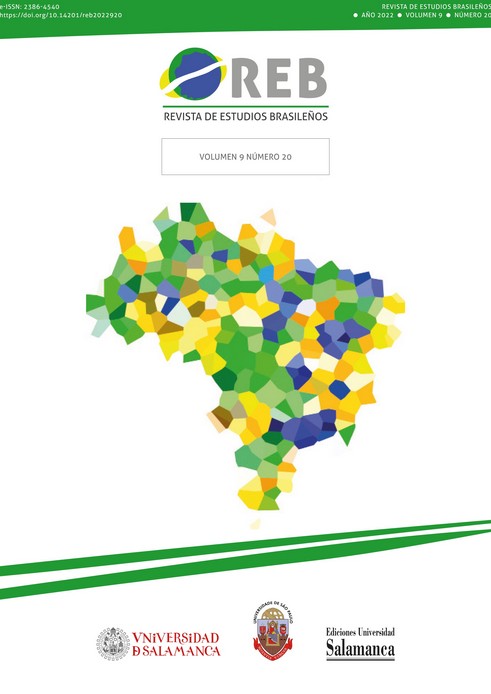Bachianas Brasileiras nº 1 por Villa-Lobos: representación de la identidad brasileña a través de la invención del género ensemble de violonchelos
DOI:
https://doi.org/10.14201/reb20229203142Palabras clave:
Heitor Villa-Lobos, Bachianas Brasileiras, ensemble de violoncelosResumen
Entre los años 1930-1945, Villa-Lobos compuso las nueve Bachianas Brasileiras, suites que combinaban elementos de la música popular y tradicional brasileña con características de la música de J. S. Bach. La primera y quinta de la serie fueron escritas para la instrumentación inusual de una «orquesta de violonchelos», una formación que casi no existía anteriormente. La síntesis estilística única de Villa-Lobos, combinada con su tratamiento tremendamente hábil para la orquesta de violonchelos, dio como resultado obras que sentaron las bases para un nuevo género, el ensemble de violonchelos. Las Bachianas Brasileiras nº 1 y 5, y especialmente la nº 1, desde entonces han sido adoptadas y celebradas por violonchelistas y grupos de violonchelos de todo el mundo. Estas obras ayudaron a formar el género, ahora floreciente, del ensemble de violonchelo y continúan hasta nuestros días como los mejores y más representados ejemplos del repertorio para el ensemble de violonchelos.
Descargas
Referencias
Barbosa, V. de M. (2005). Ibere Gomes Grosso: dois séculos de tradição musical na trajetória de um violoncelista. Rio de Janeiro: Sindicato dos músicos profissionais do estado do Rio de Janeiro.
Barros, P. C. (1951). O romance de Villa-Lobos. Rio de Janeiro: Editora A Noite.
Béhague, G. (1994). Heitor Villa-Lobos: The Search for Brazil’s Musical Soul. Institute of Latin American Studies, University of Texas at Austin.
Béhague, G. (2001). Brazil. In S. Sadie (Ed.). The New Grove dictionary of music and musicians. London: Macmillan.
Béhague, G. (2001). Modinha. In S. Sadie (Ed.). The New Grove dictionary of music and musicians. London: Macmillan.
Burle Marx, W. ([1975] 1977). Recordações de Villa-Lobos [1975], Presença de Villa-Lobos (Vol. 10, pp. 179-86). Rio de Janeiro: MEC, DAC, Museu Villa-Lobos.
Correa do Lago, M. A. (2012). Apontamentos sobre transcrições e “Works in progress” de Villa-Lobos nos anos 30 e 40. Anais do II Simpósio Villa-Lobos, Universidade de São Paulo.
Grout, D. J., & Palisca, C. V. (1988). A History of Western Music. Fourth edition. New York: W. W. Norton Company.
Hess, C. A. (2013). Representing the Good Neighbor: music, difference, and the pan American dream. New York: Oxford University Press.
Hoefs, L. (2019). Investigating Villa-Lobos, the Capadócio: plagiarism and deceit, clever recycling, or just plain lazy? Anais do V Simpósio Villa-Lobos, Universidade de São Paulo.
Hoefs, L., & Suetholtz, R. (2018). O conjunto de violoncelos: traçando a evolução de um gênero. Anais do IV Simpósio Villa-Lobos, Universidade de São Paulo.
Kiefer, B. (1986). Villa-Lobos e o modernismo na música brasileira. Porto Alegre: Movimento.
Mariz, V. (2005). Villa-Lobos - o homem e a obra (12nd ed.). Rio de Janeiro: Francisco Alves.
Negwer, M. (2008). Villa-Lobos: o florescimento da música brasileira (S. Paschoal, Trad.). Mainz: Schott Music.
Paz, E. A. (2019). Villa-Lobos e a música popular brasileira: uma visão sem preconceito (2nd ed.). São Paulo: Tipografia Musical.
Peppercorn, L. M. (1992). Villa-Lobos Collected Studies by L. M. Peppercorn. Cambridge: Scholar Press.
Pilger, H. V. (2013). Heitor Villa-Lobos, o violoncelo e seu idiomatismo. Curitiba: CRV.
Santos, E. S., & Barbosa, K. (2014). L. S. “Canta quem sabe cantar”: processos performativos na arte da embolada. Música em perspectiva, 7(2).
Villa-Lobos, H. (1948). Bachianas Brasileiras nº 1. Associated Music Publishers, Inc.
Museu Villa-Lobos. (2009). Villa-Lobos, sua obra. Catalog (3rd Ed.). Rio de Janeiro: Museu Villa-Lobos.
Wilson, E. (2008). Rostropovich: the musical life of the great cellist, teacher, and legend. Chicago: Ivan R. Dee.
Descargas
Publicado
Número
Sección
Licencia

Esta obra está bajo una licencia internacional Creative Commons Atribución-NoComercial-SinDerivadas 4.0.





